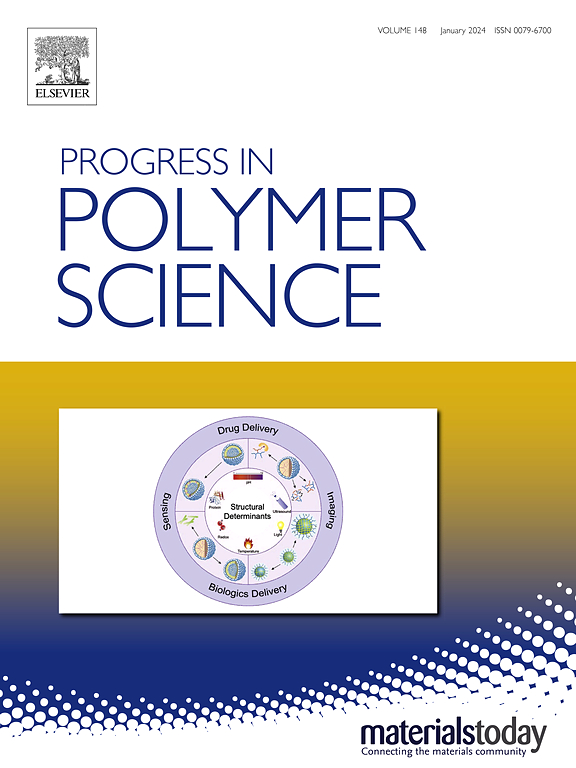合理设计用于电容储能的高温聚合物电介质:实验与计算联盟
IF 26.1
1区 化学
Q1 POLYMER SCIENCE
引用次数: 0
摘要
聚合物静电电容器在高温应用中有重要的用途,如电气化飞机、汽车、太空探索、地热/核电站、风螺距控制和脉冲电源系统。然而,现有的商用全有机聚合物电介质由于其有限的热稳定性,在高温下会遭受严重的降解和失效。因此,这些电容器需要额外的冷却系统,这需要增加系统负载和成本。传统上,无法直接预测或模拟关键性能,如热稳定性、击穿强度和能量密度,一直是此类聚合物设计的障碍。为了增强实验和本能驱动的方法来发现聚合物,最近在开发现代协同设计方法方面取得了进展。本文综述了结合人工智能(AI)、实验合成和电学表征的全有机聚合物电介质的协同理性协同设计方法的进展。重点讨论了提高电容储能性能的聚合物结构参数的确定。重要的结构元素(也称为代理)可以通过合理的协同设计方法来识别。详细介绍了人工智能的核心成分及其对加速发现新代理和聚合物的影响。该领域最近的成功和关键的后续步骤展示了协同设计方法的潜力。本文章由计算机程序翻译,如有差异,请以英文原文为准。


Rationally designed high-temperature polymer dielectrics for capacitive energy storage: An experimental and computational alliance
Polymer-based electrostatic capacitors find critical use in high-temperature applications such as electrified aircraft, automobiles, space exploration, geothermal/nuclear power plants, wind pitch control, and pulsed power systems. However, existing commercial all-organic polymer dielectrics suffer from significant degradation and failure at elevated temperatures due to their limited thermal stability. Consequently, these capacitors require additional cooling systems, that require increased system load and costs. Traditionally, an inability to directly predict or model key properties - such as thermal stability, breakdown strength, and energy density has been an impediment to the design of such polymers. To enhance the experimentation and instinctive-driven approach to polymer discovery there has been recent progress in developing a modern co-design approach. This review highlights the advancements in a synergistic rational co-design approach for all-organic polymer dielectrics that combines artificial intelligence (AI), experimental synthesis, and electrical characterization. A particular focus is given to the identification of polymer structural parameters that improve the capacitive energy storage performance. Important structural elements, also known as proxies, are recognized with the rational co-design approach. The central constituents of AI and their influence on accelerating the discovery of new proxies, and polymers are presented in detail. Recent success and critical next steps in the field showcase the potential of the co-design approach.
求助全文
通过发布文献求助,成功后即可免费获取论文全文。
去求助
来源期刊

Progress in Polymer Science
化学-高分子科学
CiteScore
48.70
自引率
1.10%
发文量
54
审稿时长
38 days
期刊介绍:
Progress in Polymer Science is a journal that publishes state-of-the-art overview articles in the field of polymer science and engineering. These articles are written by internationally recognized authorities in the discipline, making it a valuable resource for staying up-to-date with the latest developments in this rapidly growing field.
The journal serves as a link between original articles, innovations published in patents, and the most current knowledge of technology. It covers a wide range of topics within the traditional fields of polymer science, including chemistry, physics, and engineering involving polymers. Additionally, it explores interdisciplinary developing fields such as functional and specialty polymers, biomaterials, polymers in drug delivery, polymers in electronic applications, composites, conducting polymers, liquid crystalline materials, and the interphases between polymers and ceramics. The journal also highlights new fabrication techniques that are making significant contributions to the field.
The subject areas covered by Progress in Polymer Science include biomaterials, materials chemistry, organic chemistry, polymers and plastics, surfaces, coatings and films, and nanotechnology. The journal is indexed and abstracted in various databases, including Materials Science Citation Index, Chemical Abstracts, Engineering Index, Current Contents, FIZ Karlsruhe, Scopus, and INSPEC.
 求助内容:
求助内容: 应助结果提醒方式:
应助结果提醒方式:


